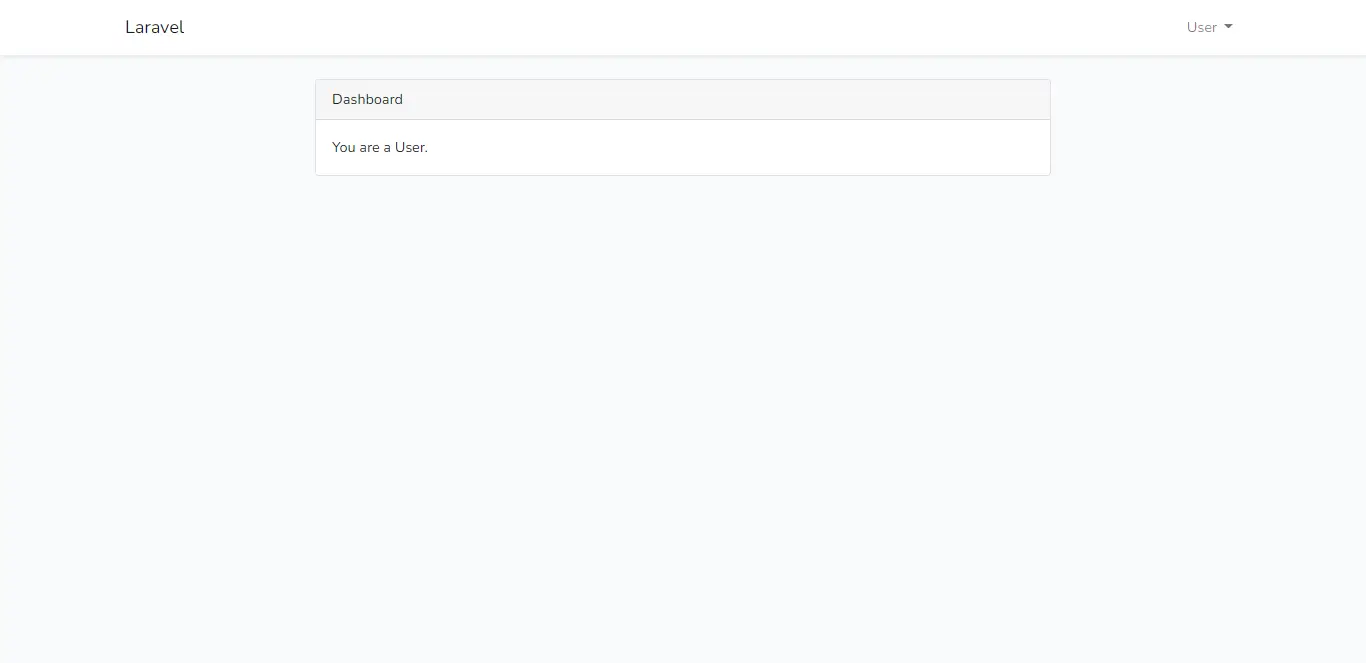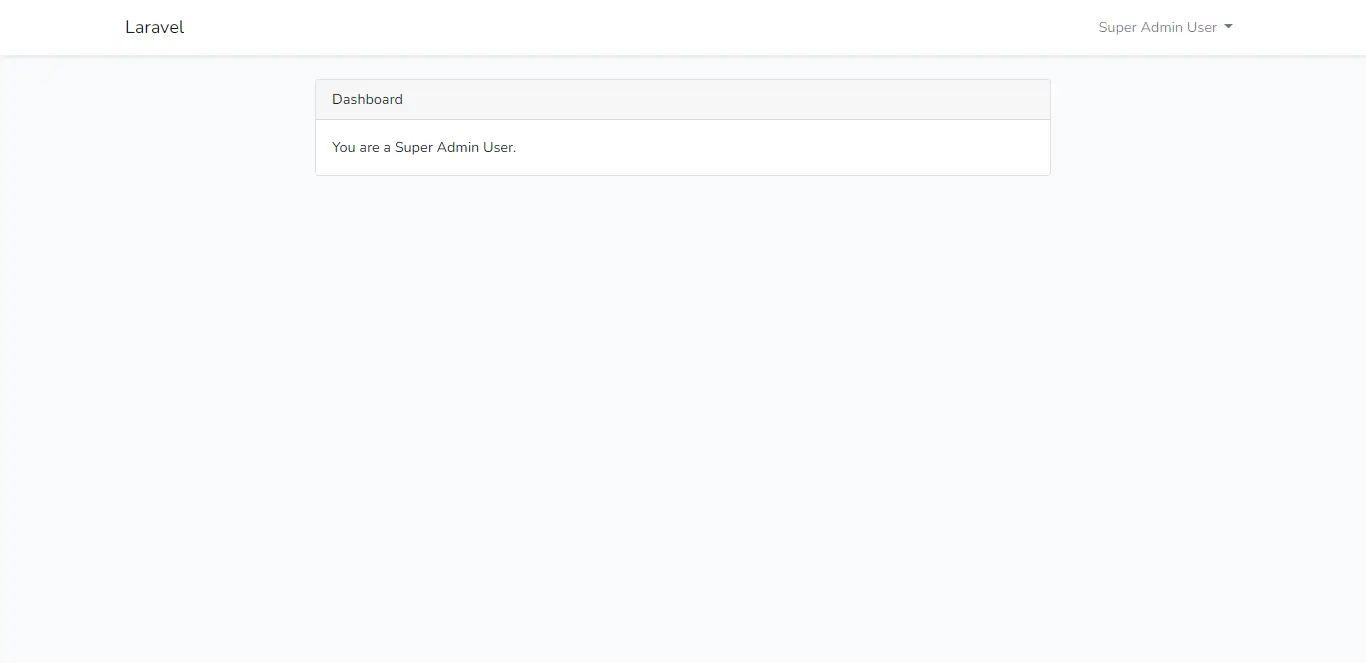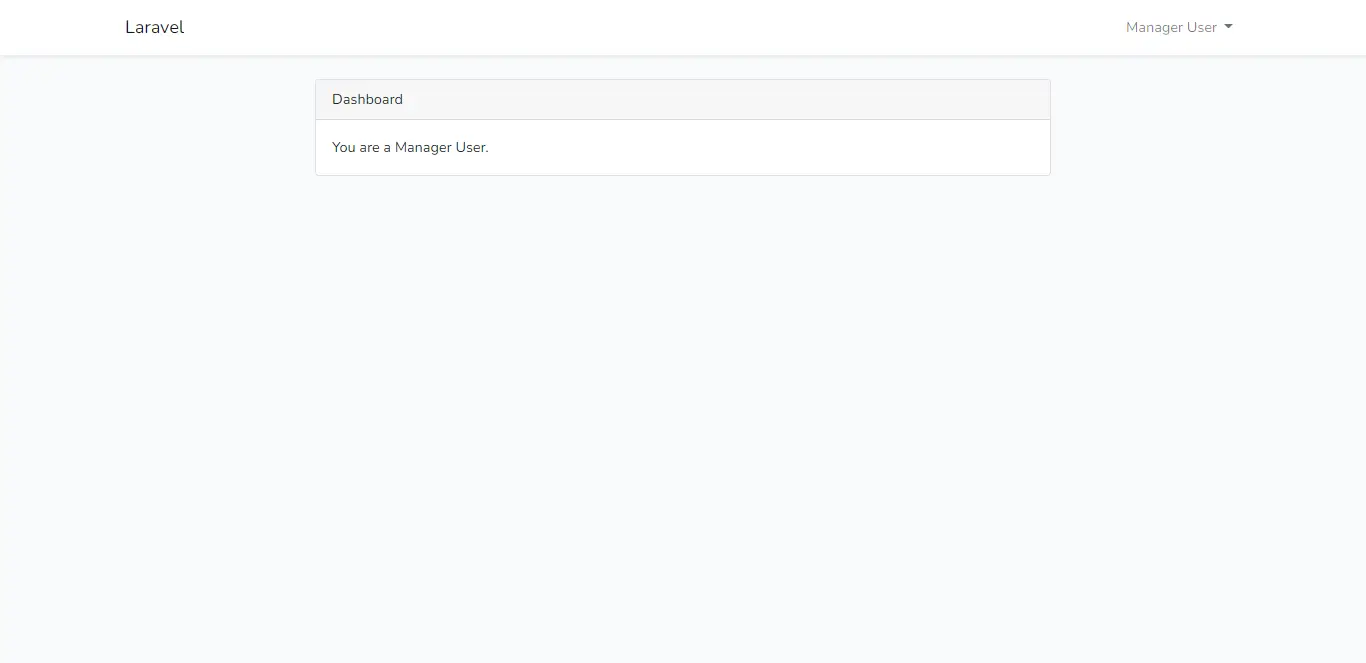10-Apr-2023
.
Admin

Hi friends,
Today, I am explain laravel 9 multiple authentication using middleware. In this post we will give you information about Multi Auth Laravel 9 | Multiple Authentication in Laravel 9. Hear we will give you detail about Multi Auth Laravel 9 | Multiple Authentication in Laravel 9 And how to use it also give you demo for it if it is necessary. In this tutorial you will learn about the Laravel 9 Multiple Authentication Using Middleware and its application with practical example. In this tutorial, you will learn how to create multi auth system in laravel 9.
Multiple authentications are very important in the large application of laravel. Authentication is the process of recognizing user credentials.
Laravel 9 multi auth system, create a middleware for checking the user’s. It is an Superadmin or normal user and manager. Then create middleware name UserAccess and configuration in the kernal.php file and also in the route file.
However, In this example, we will add the following three types of users as below:
1) User
2) Manager
3) Super Admin
When we log in as admin then it will redirect on admin routes, If you log in as manager then it will redirect on manager routes.
So, let's see follow simple steps:
Step 1: Download Laravel
Let us begin the tutorial by installing a new laravel application. if you have already created the project, then skip following step.
composer create-project laravel/laravel example-app
Step 2: Database Configuration
In second step, we will make database configuration for example database name, username, password etc for our crud application of laravel 9. So let's open .env file and fill all details like as bellow:
.env
DB_CONNECTION=mysql
DB_HOST=127.0.0.1
DB_PORT=3306
DB_DATABASE=here your database name(blog)
DB_USERNAME=here database username(root)
DB_PASSWORD=here database password(root)
Step 3: Update Migration and Model
In this step, we need to add new row "type" in users table and model. than we need to run migration. so let's change that on both file.
database/migrations/create_users_table.php
<?php
use Illuminate\Database\Migrations\Migration;
use Illuminate\Database\Schema\Blueprint;
use Illuminate\Support\Facades\Schema;
return new class extends Migration
{
/**
* Run the migrations.
*
* @return void
*/
public function up()
{
Schema::create('users', function (Blueprint $table) {
$table->id();
$table->string('name');
$table->string('email')->unique();
$table->timestamp('email_verified_at')->nullable();
$table->string('password');
$table->tinyInteger('type')->default(0);
/* Users: 0=>User, 1=>Super Admin, 2=>Manager */
$table->rememberToken();
$table->timestamps();
});
}
/**
* Reverse the migrations.
*
* @return void
*/
public function down()
{
Schema::dropIfExists('users');
}
};
Now we need to run migration.
so let's run bellow command:
php artisan migrate
Let's update User Model as below code:
app/Models/User.php
<?php
namespace App\Models;
use Illuminate\Contracts\Auth\MustVerifyEmail;
use Illuminate\Database\Eloquent\Factories\HasFactory;
use Illuminate\Foundation\Auth\User as Authenticatable;
use Illuminate\Notifications\Notifiable;
use Laravel\Sanctum\HasApiTokens;
use Illuminate\Database\Eloquent\Casts\Attribute;
class User extends Authenticatable
{
use HasApiTokens, HasFactory, Notifiable;
/**
* The attributes that are mass assignable.
*
* @var array
*/
protected $fillable = [
'name',
'email',
'password',
'type'
];
/**
* The attributes that should be hidden for serialization.
*
* @var array
*/
protected $hidden = [
'password',
'remember_token',
];
/**
* The attributes that should be cast.
*
* @var array
*/
protected $casts = [
'email_verified_at' => 'datetime',
];
/**
* Interact with the user's first name.
*
* @param string $value
* @return \Illuminate\Database\Eloquent\Casts\Attribute
*/
protected function type(): Attribute
{
return new Attribute(
get: fn ($value) => ["user", "super-admin", "manager"][$value],
);
}
}
Step 4: Create Auth using scaffold
Now, in this step, we will create auth scaffold command to create login, register and dashboard. so run following commands:
Laravel 9 UI Package:
composer require laravel/ui
Generate Auth:
php artisan ui bootstrap --auth
npm install
npm run dev
Step 5: Add UserAccess Middleware
In this step, we require to create user access middleware that will restrict users to access that page. so let's create and update code.
php artisan make:middleware UserAccess
app/Http/middleware/UserAccess.php
<?php
namespace App\Http\Middleware;
use Closure;
use Illuminate\Http\Request;
class UserAccess
{
/**
* Handle an incoming request.
*
* @param \Illuminate\Http\Request $request
* @param \Closure(\Illuminate\Http\Request): (\Illuminate\Http\Response|\Illuminate\Http\RedirectResponse) $next
* @return \Illuminate\Http\Response|\Illuminate\Http\RedirectResponse
*/
public function handle(Request $request, Closure $next, $userType)
{
if(auth()->user()->type == $userType){
return $next($request);
}
return response()->json(['You do not have permission to access for this page.']);
/* return response()->view('errors.check-permission'); */
}
}
app/Http/Kernel.php
....
protected $routeMiddleware = [
'auth' => \App\Http\Middleware\Authenticate::class,
'auth.basic' => \Illuminate\Auth\Middleware\AuthenticateWithBasicAuth::class,
'bindings' => \Illuminate\Routing\Middleware\SubstituteBindings::class,
'cache.headers' => \Illuminate\Http\Middleware\SetCacheHeaders::class,
'can' => \Illuminate\Auth\Middleware\Authorize::class,
'guest' => \App\Http\Middleware\RedirectIfAuthenticated::class,
'signed' => \Illuminate\Routing\Middleware\ValidateSignature::class,
'throttle' => \Illuminate\Routing\Middleware\ThrottleRequests::class,
'verified' => \Illuminate\Auth\Middleware\EnsureEmailIsVerified::class,
'user-access' => \App\Http\Middleware\UserAccess::class,
];
....
Step 6: Add Routes
Here, We will add following routes group where you can create new routes for users, admins and manager access. let's update code:
routes/web.php
<?php
use Illuminate\Support\Facades\Route;
use App\Http\Controllers\HomeController;
/*
|--------------------------------------------------------------------------
| Web Routes
|--------------------------------------------------------------------------
|
| Here is where you can register web routes for your application. These
| routes are loaded by the RouteServiceProvider within a group which
| contains the "web" middleware group. Now create something great!
|
*/
Route::get('/', function () {
return view('welcome');
});
Auth::routes();
/*------------------------------------------
--------------------------------------------
All Normal Users Routes List
--------------------------------------------
--------------------------------------------*/
Route::middleware(['auth', 'user-access:user'])->group(function () {
Route::get('/home', [HomeController::class, 'index'])->name('home');
});
/*------------------------------------------
--------------------------------------------
All Super Admin Routes List
--------------------------------------------
--------------------------------------------*/
Route::middleware(['auth', 'user-access:super-admin'])->group(function () {
Route::get('/super-admin/home', [HomeController::class, 'superAdminHome'])->name('super.admin.home');
});
/*------------------------------------------
--------------------------------------------
All Admin Routes List
--------------------------------------------
--------------------------------------------*/
Route::middleware(['auth', 'user-access:manager'])->group(function () {
Route::get('/manager/home', [HomeController::class, 'managerHome'])->name('manager.home');
});
Step 7: Update Controller
Here, we need add adminHome() and managerHome method for admin route in HomeController. so let's add like as bellow:
app/Http/Controllers/HomeController.php
<?php
namespace App\Http\Controllers;
use Illuminate\Http\Request;
class HomeController extends Controller
{
/**
* Create a new controller instance.
*
* @return void
*/
public function __construct()
{
$this->middleware('auth');
}
/**
* Show the application dashboard.
*
* @return \Illuminate\Contracts\Support\Renderable
*/
public function index()
{
return view('home');
}
/**
* Show the application dashboard.
*
* @return \Illuminate\Contracts\Support\Renderable
*/
public function superAdminHome()
{
return view('superAdminHome');
}
/**
* Show the application dashboard.
*
* @return \Illuminate\Contracts\Support\Renderable
*/
public function managerHome()
{
return view('managerHome');
}
}
Step 8: Add Blade file
In this step, we need to create new blade file for admin and update for user blade file. so let's change it.
resources/views/home.blade.php
@extends('layouts.app')
@section('content')
<div class="container">
<div class="row justify-content-center">
<div class="col-md-8">
<div class="card">
<div class="card-header">{{ __('Dashboard') }}</div>
<div class="card-body">
@if (session('status'))
<div class="alert alert-success" role="alert">
{{ session('status') }}
</div>
@endif
You are a User.
</div>
</div>
</div>
</div>
</div>
@endsection
resources/views/superAdminHome.blade.php
@extends('layouts.app')
@section('content')
<div class="container">
<div class="row justify-content-center">
<div class="col-md-8">
<div class="card">
<div class="card-header">{{ __('Dashboard') }}</div>
<div class="card-body">
You are a Super Admin User.
</div>
</div>
</div>
</div>
</div>
@endsection
resources/views/managerHome.blade.php
@extends('layouts.app')
@section('content')
<div class="container">
<div class="row justify-content-center">
<div class="col-md-8">
<div class="card">
<div class="card-header">{{ __('Dashboard') }}</div>
<div class="card-body">
You are a Manager User.
</div>
</div>
</div>
</div>
</div>
@endsection
Step 9: Update on LoginController
In this step, we will change on LoginController, when user will login than we redirect according to user access. if normal user than we will redirect to home route and if admin user than we redirect to admin route. so let's change.
app/Http/Controllers/Auth/LoginController.php
<?php
namespace App\Http\Controllers\Auth;
use App\Http\Controllers\Controller;
use App\Providers\RouteServiceProvider;
use Illuminate\Foundation\Auth\AuthenticatesUsers;
use Illuminate\Http\Request;
class LoginController extends Controller
{
/*
|--------------------------------------------------------------------------
| Login Controller
|--------------------------------------------------------------------------
|
| This controller handles authenticating users for the application and
| redirecting them to your home screen. The controller uses a trait
| to conveniently provide its functionality to your applications.
|
*/
use AuthenticatesUsers;
/**
* Where to redirect users after login.
*
* @var string
*/
protected $redirectTo = RouteServiceProvider::HOME;
/**
* Create a new controller instance.
*
* @return void
*/
public function __construct()
{
$this->middleware('guest')->except('logout');
}
public function login(Request $request)
{
$input = $request->all();
$this->validate($request, [
'email' => 'required|email',
'password' => 'required',
]);
if(auth()->attempt(array('email' => $input['email'], 'password' => $input['password'])))
{
if (auth()->user()->type == 'super-admin') {
return redirect()->route('super.admin.home');
}else if (auth()->user()->type == 'manager') {
return redirect()->route('manager.home');
}else{
return redirect()->route('home');
}
}else{
return redirect()->route('login')
->with('error','Email-Address And Password Are Wrong.');
}
}
}
Step 10: Add Seeder
We will create seeder for create new admin and normal user. so let's create seeder using following command:
php artisan make:seeder CreateUsersSeeder
<?php
namespace Database\Seeders;
use Illuminate\Database\Console\Seeds\WithoutModelEvents;
use Illuminate\Database\Seeder;
use App\Models\User;
class CreateUsersSeeder extends Seeder
{
/**
* Run the database seeds.
*
* @return void
*/
public function run()
{
$users = [
[
'name'=>'User',
'email'=>'user@nicesnippets.com',
'type'=>0,
'password'=> bcrypt('123456'),
],
[
'name'=>'Super Admin User',
'email'=>'super-admin@nicesnippets.com',
'type'=>1,
'password'=> bcrypt('123456'),
],
[
'name'=>'Manager User',
'email'=>'manager@nicesnippets.com',
'type'=> 2,
'password'=> bcrypt('123456'),
],
];
foreach ($users as $key => $user) {
User::create($user);
}
}
}
Now let's run seeder:
php artisan db:seed --class=CreateUsersSeeder
Run Laravel App:
All steps have been done, now you have to type the given command and hit enter to run the laravel app:
php artisan serve
Now, you have to open web browser, type the given URL and view the app output:
http://localhost:8000/login
Now, Let's login with following credentials:
Normal User:
Email: user@nicesnippets.com
Password: 123456

Super Admin User:
Email: super-admin@nicesnippets.com
Password: 123456

Manager User:
Email:manager@nicesnippets.com
Password: 123456

I hope it can help you...
#Laravel 9